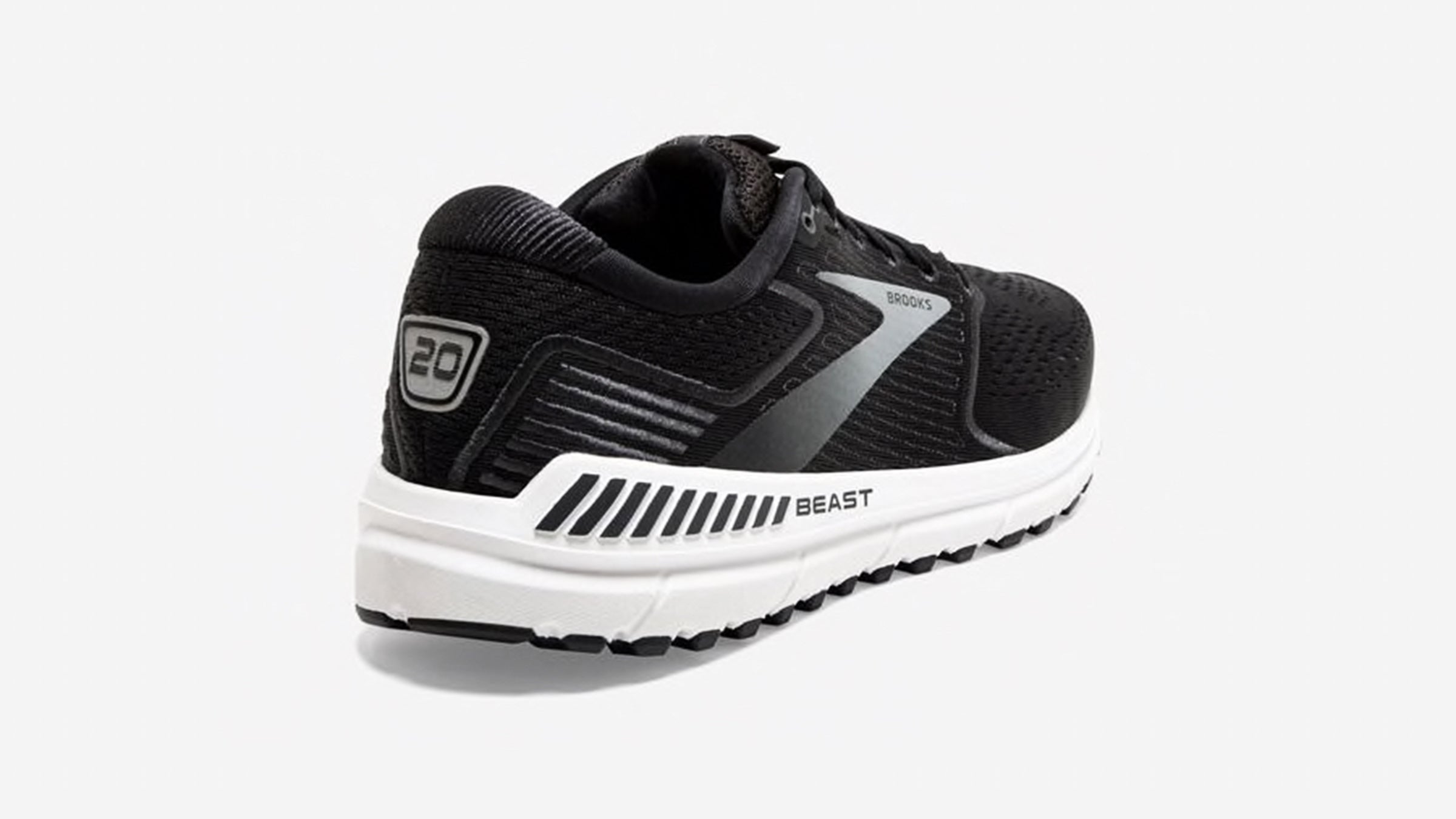When the Brooks Beast 20 came out in spring 2020, something was missing from the venerable shoe that has defined the ultimate in motion-control since 1992: it no longer had a medial post to reduce pronation. Brooks began eliminating posts from their stability line a couple of years ago, and now all Brooks’ shoes are post-less except the “max support” , and even its post will disappear in 2021. Whether you view this as a sign of the apocalypse or a harbinger of a new enlightened age, the departure, from a company known for motion control, marks a turning point in how we think about stability. Many say it is about time.
Never a Control Issue
Everyone in the industry agrees that the connection between motion and injury has been suspect for years. In his 2010 book, Biomechanics of Sports Shoes, kinesiology professor Benno Nigg wrote, based on his studies over the previous decades, “Pronation is a natural movement of the foot and ‘excessive pronation’ is a very rare phenomenon. Shoe developers, shoe stores, and medical centers should not be too concerned about ‘pronation’ and ‘overpronation.’”
“The science has been around since well back into the ’90s,” says Spencer White, VP of Saucony’s Human Performance & Innovation Lab. “There is no correlation between how much the foot moves and who is getting hurt. It doesn’t matter how much you pronate, it matters whether your body can handle how much you pronate. It’s not a motion thing, it is a stress on the body thing.”
Not only is pronation rarely bad, but devices in shoes do a poor job of controlling it, even if we wanted to.
“In a motion control shoe, the foot is rotating very nicely on top of that platform — it’s not doing anything,” explains Simon Bartold, podiatrist, shoe consultant and blogger (@bartoldbiomecha).
Physical therapist and author Jay Dicharry says, “Do you really think an 8 to 13 ounce piece of material is going to stop or control or eliminate motion in a 180 to 200 pound skeleton? No.”

Photo: Dustin Renwick
What The Shoe Does Do
This is the type of evidence and reasoning that led to the minimalist movement, and on this point, the minimalists weren’t wrong. They also weren’t wrong about shoes being a source of the problem. Experts agree that control features in a shoe are solving an issue created by the shoe itself.
“I don’t think there are shoes that make our body more stable, but there certainly are shoes that make our body less stable,” says Geoffrey Gray, president of the Heeluxe biomechanics lab. “The closer we get a foot to the ground, in general the more stable it is going to be. But that’s also going to exact a price on other features we like in a shoe.”
Shoes primarily provide cushioning—both impact reduction and spreading forces underfoot. But cushioning and distance from the ground creates instability. Some people have no problems with that instability, while others need or prefer additional structure underfoot to help counteract it.
Keep in mind, however, that even a structured shoe doesn’t physically control motion. “Your foot is an actively modulated spring. Your body controls what those bones do—they are not controlled by a shoe,” says Dicharry. “What you’re trying to do is find the right filter between you and the ground.”
“The shoe is providing a signal to the brain that enables the movement pattern,” Bartold says. Nigg agrees: “I think that the shoe is more a proprioceptive instrument than it is a mechanical instrument. It seems not to be the mechanical effect of the support, it seems to be the neuromotor effect that the supports provide.”
This doesn’t mean stability devices are entirely about feel and could be replaced with a well-placed thorn in your sock (although that would clearly reduce motion). “The shoe is actually doing some physical work—just not very much,” says White. “It doesn’t dramatically change how your body moves, but it does change how that force is distributed under your foot. The body is adapting because of how load is being applied under the foot.”
And changing the loading of the foot helps some runners, even if it isn’t altering their motion path. “Just because a shoe doesn’t control the motion of a foot, doesn’t mean there aren’t some runners who really need a shoe that does have some added level of stability built in,” says White.
Nigg admits that, even though we can’t prove they prevent injury, stability shoes work better for some runners. “Some people like to have support under the arch, and some people don’t like that. And the group that likes support under the arch is not a small group,” Nigg says. “To have a control shoe on the market is nothing bad, it just doesn’t control.”
Podiatrist and professor of applied biomechanics Kevin Kirby agrees that science hasn’t proven that dual-density midsoles work—but also hasn’t proved that they don’t, and in clinical practice he’s seen them help runners. “Anything that limits medial midsole deformation, for some runners, is going to be very beneficial and comfortable,” says Kirby. “It would be a mistake to totally eliminate some sort of stability or motion control shoes for those who need it.”

The guide rails on Altra’s Paradigm are an extension of the midsole, providing proprioceptive feedback only when the foot tires and begins to move excessively. Photo: Altra
Why Change?
Regardless of why they work, if motion-control shoes with medial posts have helped runners, why should the industry change?
“The potential benefit in the dual density midsole shoe is durability,” says Bartold. “But the penalty is weight, the penalty is lack of feedback, the penalty is ride—there are so many different things.”
Brooks echoes these ideas explaining why their new technology is an improvement. “Moving away from a bigger, blockier post, you’re going to experience more of the cushioning you want underfoot,” says Jon Teipen, Senior Global Footwear Product Line Manager at Brooks. “Also the shoe’s going to be lighter, transition better.”
Rather than a post, what you’ll find in the new Beast and other Brooks stability shoes is called “guiderails”—firmer material on top of the midsole running along the perimeter of the heel and midfoot. In addition to being lighter and smoother, the guiderail promises to be less prescriptive than a full post, thus it should work for a wider range of runners.
“It doesn’t go all the way down to the ground, so gives the shoe a little bit of play,” says Teipen. “It’s not going to be a firm block on the medial side of the shoe. The more you evert, the more the guiderail will push back on you.” The rail also provides support on the lateral side of the heel, designed to reduce sideways rotation of the heel that puts strain on the knee.
Many Roads to Stability
Expanding the ways shoes provide stability is a welcome change. Bartold says, “What Brooks has done with the guiderails seems like a far more sensible design feature than any form of dual density, because, in effect, it will give a total foot-cradling effect.”
Brooks isn’t the only company using such a system. Altra has had guiderails on their Paradigm since it’s inception over six years ago, enhancing the stability inherent in their wider, foot-shaped and zero-drop geometry. “The Guiderails do not affect the foot when it is functioning correctly,” says co-founder Golden Harper. “However, when the foot starts to fatigue or collapse in too much, the foot hits the GuideRail which then causes a proprioceptive reaction to track straighter.”
Hoka’s shoes, dating from their first model in 2010, have also provided stability through a cradling geometry. “When we sat the foot deeper down into the midsole and kept the platform wide enough, that seemed to create a more stable ride for a variety of runners,” says Hoka Global Product Line Manager Zack Paris. “Those sidewalls created the ‘active foot frame,’ and they’re designed to act as rails to guide the foot, rather than push the foot outwards.” The J-frame you find on Hoka’s stability models simply reinforces this geometry cradling the heel and midfoot.
Beyond guiderails, brands are starting to explore a wide variety of strategies to improve both the holistic stability of shoes and their ride. White and Grey talk about landing zones that don’t increase the torque around the joints of the foot. Bartold mentions . Dicharry discusses ground feel, last shape, plates, foams.
“Stability is a function of so many features such as sole geometry, stack height, midsole hardness, outsole, upper materials and how they are structured—not just medial posting,” says Kurt Stockbridge footwear development vice president at Skechers Performance. “Each of these levers can be pushed and pulled to make a great stability shoe without it having to look like what we typically picture today.”

The J-frame on Hoka’s Arahi adds structure and durability to the foot-cradling geometry that stabilizes the ride in all Hokas. Photo: Hannah DeWitt
Evolution Overcoming Inertia
The move away from a simplistic, single-solution idea of motion control shouldn’t be a shock. “The community is taking a large gasp of surprise that Brooks has done this,” says Bartold. “I don’t think we should be surprised; it is a natural progression based on the science of the day, that’s where we’re going.
White says, “I wouldn’t say there has been a giant revolution in our understanding as much as a steady evolution that has consistently shown that it’s not a simple matter of measuring the motion of the heel to determine if you need some added stability.”
If anything, the surprise should be that the industry has been so slow to evolve. The knee-jerk reaction of minimalism and its backlash may have slowed progress in the public perception. But mostly, it comes down to inertia. “We’ve got consumers who have had a positive experience, and any time we’ve had a positive experience, we want to go back to that. It’s a big step for that consumer to say I’m going to derail myself from what I’m used to,” says Tom Garza, Product VP of Global Footwear at 361°.
The simple solution has also been easy to sell. “You put a device in there, the perception is you’re controlling something,” says Garza. “It’s the first thing the consumer identifies with support—when you walk to the wall and turn that shoe around and see the medial grey matter, the consumer today has been educated enough to know, ‘That is my support shoe.’ That is the giant hurdle: perception is reality.”
If nothing else, the gradual elimination of the medial post should help the running industry move away from the view that stability equals reducing pronation. Perpetuating a one-dimensional sort for footwear has done a disservice to the running community.
Moving away from assessing pronation to talking about forces and levers and load attenuation can be overwhelming. “The challenge is coming up with a simple way to communicate what is a very complicated set of physics and biology,” says White. That is a challenge we can all embrace as we explore the increasingly complex—and exciting—array of workable options.


